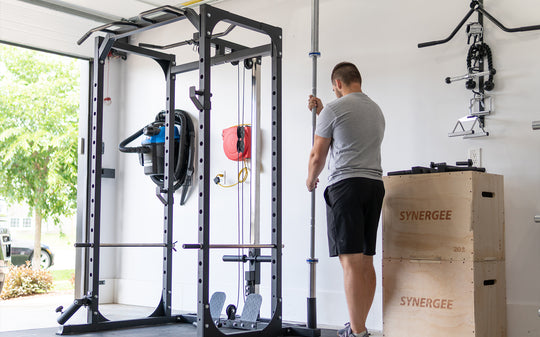Maximize Your Squats: 4 Important Components Of Squat Training

Seriously into squatting?
Then you seriously need to get into these squat drills!
Add these 4 components to your squat program and your Rhino Bar will travel smoother, faster, and with more pounds on either side!
Especially if you've hit a plateau lately, these drills will target the exact trouble spots that are holding you back from hitting a new PR. From fixing mechanics to intentionally attacking the bottom sticking point, these drills are intended to make your squatting muscles stronger and more powerful.
Plus, they'll let you get all the value out of your Rhino Bar!! Performing these drills as warm-ups before your squat programming will unleash that beast!!
Wall Squats
Adding weight won’t fix your squat; fixing the mechanics will!The wall squat will identify the areas you need to fix – tight hips and ankles, a weak chest/lower back – and help you develop your flexibility and muscle strength.
Wall Squats are performed without weight, while standing close to and facing a wall.
First, get into position: stand no further than a foot width (NOTE: not a foot length) away from the wall. Stand with your feet shoulder-width apart and your hands above your head. Place your hands on the wall, arms parallel to each other.
Then perform a squat. Send your hips back and lower yourself down. Keep your hands on the wall and allow them to slide down as you descend. Do not let your knees or head touch the wall.
Focus on pushing your knees out and keeping your chest raised. If you want to make it more difficult, stand closer to the wall. If you cannot complete your squat without your body touching the wall, take a step away from the wall.
Pause Squats
Ready to add some weight? We’ll also add some WAIT.
This drill involves pausing at the bottom of the squat, and then driving upwards. Sitting at the bottom of the squat will put your legs under tension for longer, and forces fast and slow twitch muscle fibers to kick in. The more you practice this pause, the more muscular strength you will develop to drive up out of the hole.
This will also benefit your cleans and snatches when you find yourself in the catch, pinned under the bar.
Perform a barbell squat as normal, but when you reach the bottom position pause for 1-3 seconds. Keep your chest up, knees out, and butt squeezed throughout. Drive up quickly to explode out of the hole.
We advise starting with a lower weight – you don’t want to get stuck! For example, 3 sets 3 reps at 70% with a 3 second pause.
Anderson Squats
This is another squat variation that focuses on the bottom of the squat. Because, of course, the descent is rarely the problem: the standing up is where it gets rough!!
The Anderson Squat is like a squat in reverse. Start at the bottom, stand, and squat down to set the bar on the pegs again.
Set up your loaded Rhino Bar on blocks or pins (it will be hard to complete the movement from J cups) at a height much lower than normal. It should be at the approximate height your bar would be when you sit in the bottom of your squat.
Get under the bar, set up in your bottom squat position, and then stand up with the bar. Squat back down to set the bar on the pins/blocks again. You got no momentum – only strength – to get that bar up!
Try not to slam yourself up into the bar (i.e. don't jerk it off the pins/blocks). Hold onto the bar, pull it into your back, and stand up smoothly and powerfully. Likewise, return to the bottom of your squat in a controlled manner.
Little Tweaks
There are two other cues to keep in mind while squatting, and they involve your wrist and head position. These may seem inconsequential, but where your wrists and head are during your squat can be the difference between bailing it or nailing it!
WRISTS:
Keep your wrists active and straight when you back squat. Don’t let them get lazy and bend back with the bar.
Grip the bar and engage your hands/wrists such that they help your upper back remain tight and upright during your squat. Especially when you stand up from the bottom, drive your heels into the ground and push your hands up into the bar to apply force with your whole body.
HEAD:
Keep a neutral head position throughout your lift to avoid going too far forward or back. Personally, I like to keep my eyes on an item a few feet ahead of me on the floor. That way, I’m not looking straight down or craning my neck up.
Looking down can cause you to shift your weight too far forward; looking up can shift you too far back. Find a spot that allows you to look ahead of you naturally.
BONUS TIP: Use the Right Tools!
Ok, one more thing. Use a bar intended for squatting!
Our Rhino Bar is made from steel and has a Cerakote-coated shaft with Black Phosphate sleeves. At 45 lbs and 29 mm diameter, this bar is meant for a serious lifter. It has aggressive (but not sharp) volcano knurling, 1500 lb weight capacity, center knurling, and one set of powerlifting marks. It is rigid, has little whip, but still exhibits a smooth spin thanks to it's bushings.
It's meant to be squatted. Check it out here. Financing options are available.










